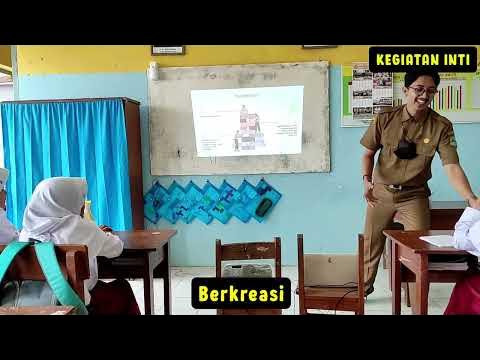Model Pembelajaran Investigasi Kelompok
Summary
TLDRThis educational video introduces the Group Investigative Learning Model, a student-centered approach that encourages active participation in learning. The model involves six key steps: identifying a topic, planning the investigation, conducting research, preparing a final report, presenting findings, and evaluating the process. It fosters communication, teamwork, and critical thinking skills while deepening students' understanding of topics. Through collaborative inquiry, students not only learn academic content but also develop real-world skills such as data gathering and analysis. The video emphasizes the importance of student independence, social interaction, and practical application of knowledge.
Takeaways
- 😀 Group investigation learning model encourages active participation and collaboration among students.
- 😀 The model includes six key steps: identifying topics, planning, conducting investigations, preparing reports, presenting findings, and evaluating the process.
- 😀 The group investigation model promotes critical thinking, communication skills, and teamwork in students.
- 😀 Students are encouraged to explore real-world issues through in-depth investigation, such as social conflicts in this example.
- 😀 Groups should collaborate and assign tasks based on each member's strengths to efficiently conduct their investigations.
- 😀 Teachers can facilitate the investigation by providing resources such as books, articles, and even interviews with experts.
- 😀 The group investigation model supports the integration of various learning sources, including textbooks, interviews, and digital resources.
- 😀 Presenting the final report is a crucial part of the learning process, helping students hone their presentation and public speaking skills.
- 😀 The model fosters a learning environment where students can contribute ideas and insights, enhancing their intellectual development.
- 😀 Reflection and evaluation of the investigation help students analyze their work and gain insights into the effectiveness of their approach.
- 😀 By the end of the lesson, students should understand the subject matter more deeply and learn practical skills such as data collection, analysis, and presentation.
Q & A
What is the main goal of the Group Investigation model in education?
-The main goal of the Group Investigation model is to engage students actively in the learning process, encouraging them to work collaboratively, conduct investigations, analyze topics, and present their findings, which helps develop their communication, teamwork, and critical thinking skills.
What are the six steps involved in the Group Investigation model?
-The six steps of the Group Investigation model are: 1) Identifying a topic for investigation and dividing students into groups, 2) Planning the investigation process, 3) Conducting the investigation, 4) Preparing a final report, 5) Presenting the final report, and 6) Evaluating the process.
How does the Group Investigation model benefit students' intellectual development?
-The model enhances students' intellectual development by promoting active learning, encouraging them to explore topics deeply, collaborate in groups, and present their findings. This process sharpens their analytical thinking and problem-solving abilities compared to individual learning methods.
What type of skills do students develop when using the Group Investigation model?
-Students develop a range of skills, including communication, teamwork, critical thinking, research, and presentation skills. The model also encourages social skills, as students collaborate and engage in discussions, respecting others' viewpoints and contributing to a collective goal.
What resources can students use for their investigations in the Group Investigation model?
-Students can use various resources such as textbooks, articles, videos, interviews with experts, and visits to relevant locations (like libraries, offices, or community centers) to gather data and insights for their investigations.
Why is it important for students to plan their investigation process in the Group Investigation model?
-Planning the investigation process is crucial because it helps students organize their tasks, delegate responsibilities within the group, and ensure that they approach the topic systematically. This step is key to conducting effective and focused research.
How does the Group Investigation model encourage collaboration among students?
-The Group Investigation model requires students to work in teams to research a common topic. They must communicate, divide tasks, share findings, and collaborate to analyze and present their conclusions, which fosters cooperation and teamwork.
What role do teachers play in the Group Investigation model?
-In the Group Investigation model, teachers act as facilitators and guides. They support students by helping them identify relevant topics, providing resources, answering questions, and monitoring the group's progress, while allowing students to take the lead in their learning process.
What is the significance of presenting the final report in the Group Investigation model?
-Presenting the final report is important because it allows students to articulate their findings, demonstrate their research skills, and share their conclusions with the class. It also provides an opportunity for peer learning, as students can critique and learn from each other's investigations.
What impact does the Group Investigation model have on students' social skills?
-The Group Investigation model has a positive impact on students' social skills by encouraging them to interact with peers, work in teams, resolve conflicts, and respect different viewpoints. These social interactions help them build relationships and enhance their interpersonal skills.
Outlines

此内容仅限付费用户访问。 请升级后访问。
立即升级Mindmap

此内容仅限付费用户访问。 请升级后访问。
立即升级Keywords

此内容仅限付费用户访问。 请升级后访问。
立即升级Highlights

此内容仅限付费用户访问。 请升级后访问。
立即升级Transcripts

此内容仅限付费用户访问。 请升级后访问。
立即升级浏览更多相关视频

Desain dan Cara Optimalisasi Pembelajaran Interaktif

Model Pembelajaran Think Pair and Share - Andin Rizki Aulia

Model Pembelajaran Berbasis Lingkungan - Mirma Lutfiatunnisa

Pembelajaran Project Citizen Prodi PPKn FKIP (UNIVERSITAS MANDIRI) Kelompok 5

Student Centered Learning: Why, How, & What

Model Pembelajaran Think Pair Share (TPS) Berbasis Sosial Media
5.0 / 5 (0 votes)
